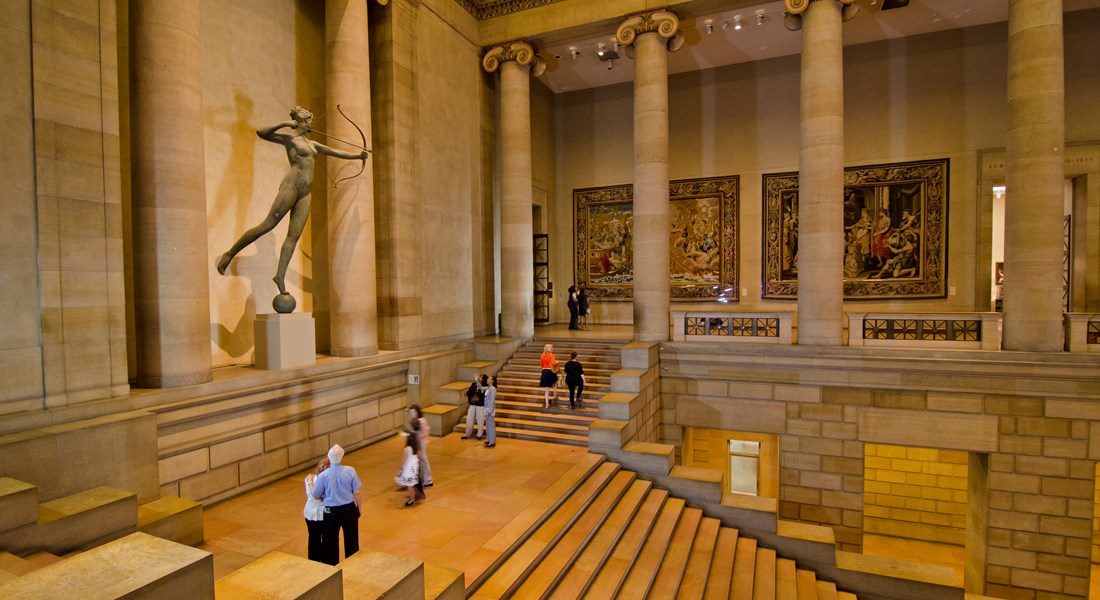Posted1 Sep 2017
- In
War Stories: Setting Up Camp
War Stories director Robin Guarino defines the spaces inside a museum to create a modern stage for an opera
Beyond knowing the craft and the medium, opera “makers” must possess the ability and flexibility to collaborate with constantly changing companies. Like nomads we travel from place to place “setting up camp” for the next production. We have to be nimble and responsive to change and thankfully our theatre training teaches us to coexist well with the “unknown.” In searching for the truth, we cannot honestly know the outcome ahead of time. We venture out into the world and amongst the people: the alternative venue. We collaborate outside of our comfort zone across art institutions and outside of theaters.

When I first directed an opera at a museum, I learned the difference between curators, docents, and stage directors pretty quickly. I learned that curators and docents were often trying to restore, curate, protect, and display what stage directors threatened to dismantle and explode. The normal questions of stage footprint versus audience seating became part of the concept out of necessity. What are you going to do with the space? Where does the orchestra go? Will they have enough light to read their music and what will keep the light from going in their eyes? Can the singers see the conductor? “Don’t touch the art!” It was a challenge after all those questions were answered to actually find the concept. Needless to say, I was apprehensive before our first meeting for staging War Stories at the Philadelphia Museum of Art.
To my surprise and joy, our first meeting was the opposite of what I feared. In The Philadelphia Museum of Art and Opera Philadelphia we found a group of like-minded collaborators. The museum staff kept offering ideas and showing their enthusiasm and curiosity. The production staff of the Opera was open-minded, adventurous, and enthusiastic, both institutions eager to push the boundaries and both interested in becoming agents of change in their community and vital on the frontline of possibility. We made site visits together and separately as we came to know each other as one creative producing team.
We knew from the beginning that we wanted to use the great stairs and the cloisters as our performance sites. War Stories is a double-bill uniting Monteverdi’s Il Combattimento di Tancredi e Clorinda, a text setting drawn from Torquato Tasso’s La Jerusalem Liberate – Canto XII, and combining it with the Philadelphia premiere of Lembit Beecher and Hannah Moscovitch’s work, I Have No Stories to Tell You in a single evening. Both works are “Romances” set in the context of struggle between man and woman; the Monteverdi against the backdrop of the First Crusade, the Beecher in an unnamed contemporary war. Both struggles are set and told in the context of a journey; the Combattimento on horseback and in hand-to-hand combat and I Have No Stories in the bedroom, in the halls and in the shrapnel of PTSD-induced flashbacks of the frontline, issues of consent, safety, and rape in the military.
The performance of I Have No Stories is staged on a marital bed being dragged up the great staircase of the museum. The staging was inspired by the story of the Columbia University student Emma Sulkowicz who had carried her mattress on her back as an act of protest that her rapist was neither found guilty or expelled from school.
In I Have No Stories, the protagonist Sorrel wakes every night beside her husband remembering the frontline. As he questions and then more aggressively interrogates, her memories literally drag them up the stairs to relive the experience. Combattimento is performed in the museum’s 14th century cloister where a military campsite has been set-up. Tancredi and Clorinda are portrayed by the husband and wife in I Have No Stories. Members of the ensemble narrate the story of their battle as the audience gathers to surround them.
“Teamwork” is the word that comes to mind in this kind of collaboration. We have never stopped talking. We the composer, librettist, director, conductor, singers, set, costume, and lighting designers, production managers, artistic administrators, and directors, and sound designers, and Museum staff. The War Stories Dropbox folder keeps growing and we have conference calls with the opera and the museum team at least once a week. At the heart of all of this is communication: Asking a lot of questions, listening and responding and setting up our collective camp.
Leave your comment below.

 Facebook
Facebook Twitter
Twitter More
More